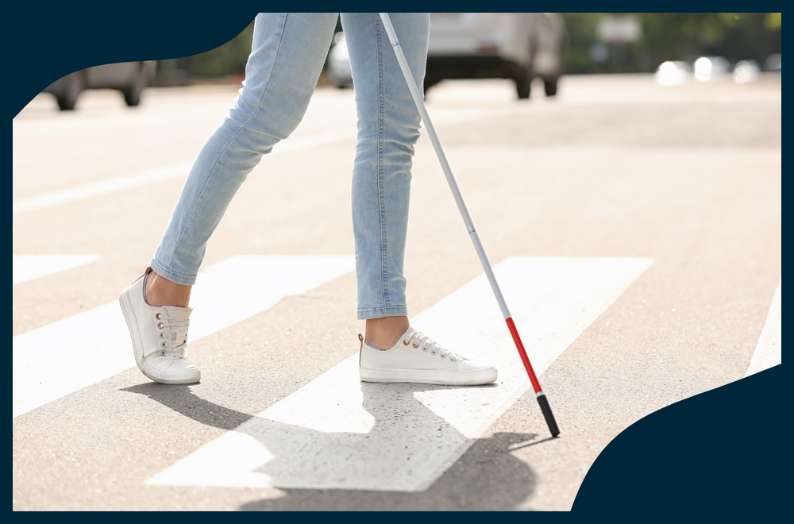For many people, the decision to start using a white cane is as much about identity as it is about mobility. The transition to using a white cane can bring up a mix of emotions, from relief and confidence to self-consciousness and uncertainty. You might worry about how others will perceive you, whether it will change the way people interact with you, or if you’ll feel different than you did before.
Nearly every white cane user has been in your shoes at some point. And while it can take time to adjust, using a white cane can ultimately provide more freedom, confidence, and independence.
Our CEO, John Samuel, knows this journey firsthand. It took him three separate attempts before he fully embraced using a cane. At first, he resisted, seeing it as a symbol of blindness he wasn’t ready to accept. Later, frustration took over, and he found himself blaming the cane when the learning experience didn’t go as smoothly as he had hoped. But when he finally felt ready to use a white cane, it became a tool that helped him navigate his surroundings with confidence.
If you’re feeling anxious about using a white cane, that’s completely normal. Adjusting to any kind of change can take time. There’s no right moment to start using a cane; everyone reaches that point at their own pace. What matters is approaching this transition when it feels right for you. In this article, we’ll explore common concerns about using a white cane and provide insights to help you feel more confident in your transition when the time comes.
Overcoming Common Concerns About Using a White Cane
In this section, we will address three common questions that people tend to have when considering using a white cane.
One: Will using a white cane change how people interact with me?
It might, but not always in the way you fear. Some people may hesitate to talk to you because they don’t want to say the wrong thing, while others may offer help even when you don’t need it. As our CEO, John, explained, “One thing I noticed was that there were a lot of people who weren’t talking to me. And what I realized was that my white cane became this shield—this force field that people didn’t want to cross.” But over time, he realized that having the cane also meant fewer misunderstandings. Instead of people assuming he was rude or distracted when he bumped into things, they understood that he was blind.
Two: What if I trip someone or knock something over?
It’s a common fear, but one that gets easier with experience. With proper orientation and mobility (O&M) training, you’ll learn techniques that help you move smoothly through different environments. Plus, most people adjust quickly when they see a cane. If they bump into it, they’ll likely apologize to you.
Three: What if I don’t feel ready to use a white cane yet?
That’s okay. Everyone makes this transition at different times. Some people start by using their cane only in certain situations, like at night or in crowded spaces. Others take time to get comfortable using it privately before bringing it into their daily routine. The important thing is to find what works for you.
How to Get More Comfortable Using a White Cane
If you’re feeling hesitant about using a white cane, here are three things that might help.
One: Give Yourself Time to Adjust.
It’s completely normal to feel self-conscious at first. Many long-time cane users say that the discomfort fades the more they use it. If folding it up and putting it away feels tempting, remind yourself why you started using it in the first place: safety, confidence, and independence.
Two: Get Orientation & Mobility Training.
If you’re worried about tripping others or knocking things over, training can help. Learning proper techniques can make using a white cane feel more natural and increase your confidence in navigating different spaces.
Three: Connect with Other White Cane Users.
Knowing that others have been through the same thing can make a huge difference. Many people who have gone through this adjustment find that having a community, whether online or in person, helped them feel more empowered.
What to Expect When You Start Using a White Cane
As with anything new, we tend to wonder what the experience will be like. It’s human nature to feel anxious about change and to want to know what to expect. The good news is that everyone’s experience is different, so you can approach this transition in any way that feels right to you. You are in control of your own journey. But to ease some nerves, we’ll share a little bit about our CEO, John Samuel’s experience.
Once John started consistently using his white cane, he noticed his confidence growing. At first, he practiced using it in environments where he felt less exposed, but as time went on, he realized it gave him more freedom to navigate independently.
“It changed my life the moment I started accepting it,” he said. “It took me a long time to come to that because it is part of that acceptance process of going blind. And it’s not about, for me, not bumping into people. What it did was it allowed me to tell people non-verbally, I can’t see. And that speaks volumes.”
Instead of feeling like the cane set him apart in a negative way, he realized that it actually helped people understand his needs, without him having to explain. Rather than feeling the need to justify why he struggled with certain tasks or environments, his cane served as a silent communicator. With that understanding came smoother interactions, less frustration, and a greater sense of control.
Everyone’s journey with a white cane is unique, and there’s no single right way to adjust. But what John’s experience shows is that when you’re ready to embrace it, the cane can become a source of confidence and independence rather than something to fear.
Conclusion
At the end of the day, a white cane is a mobility tool, it does not define who you are, it does not make you a burden, and it certainly is not something to be ashamed of. It’s there to help you move through the world more safely and confidently.
If you’re struggling with the transition, be patient with yourself. Learning something new doesn’t happen overnight, but every time you pick up that cane, you’re moving one step closer towards a safer and more independent life. And that’s something worth celebrating.
At Ablr, we’re here to support you as you navigate life with sight loss. Click here to follow along on our blog for helpful tips, advice, resources, and stories that educate, inspire, and empower.






